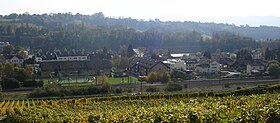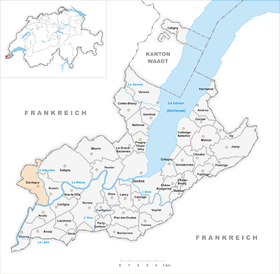Dardagny
| Dardagny | |
|---|---|
| State : |
|
| Canton : |
|
| District : | No district division |
| BFS no. : | 6620 |
| Postal code : | 1282 |
| Coordinates : | 488 560 / 116976 |
| Height : | 434 m above sea level M. |
| Height range : | 346–506 m above sea level M. |
| Area : | 8.60 km² |
| Residents: | 1864 (December 31, 2018) |
| Population density : | 217 inhabitants per km² |
|
Proportion of foreigners : (residents without citizenship ) |
28.4% (December 31, 2018) |
| Website: | www.dardagny.ch |
|
La Plaine |
|
| Location of the municipality | |
Dardagny is a municipality in the canton of Geneva in Switzerland . It is almost at the westernmost point of the country and consists of the villages of Dardagny and La Plaine and the hamlets of Malval , Essertines , La Tuilière and Les Granges .
geography
Dardagny is on the border with France on the Rhone . Located on the Ruisseau des Charmilles stream , its Château de Dardagny offers a romantic atmosphere that is second to none. The Ruisseau des Charmilles flows past the edge of the village .
history
A hatchet was found from the Neolithic Age . Finally, from the year 1093, the construction of the Saint-Pierre church is reported, which today stands in the middle of Dardagny.
Amyon de Dardagny , the first lord of the castle, knight and crown vassal of Geneva , was first mentioned in 1280 when he received 30 books in a will. At this point in time there were three mighty houses in the Dardagny area: the southern house, represented by André de la Corbière , the northern house, represented by Michaud de Livron , and the central house, represented by Amyon de Dardagny. The village itself was first mentioned in 1309 as "Dardaniacum".
As a result of the reforms in 1536, the area around Châteauvieux , Confignon and Dardagny passed into the hands of the Geneva Republic . It was not until 1646 that the Geneva regent Amédée Favre succeeded in reuniting the two rulers under his rule. In 1655, his son Daniel Favre united the two other houses into one, a measure that he simply enforced through structural measures.
Later, in 1721, a Dutch nobleman named Jean Vasserot bought the rule of Dardagny from the Lullin family who ruled the area at the time. When he died in 1731, his son took over the rule and invested a lot of time and material in the castle, which was transformed from a medieval, sparsely furnished castle into one of the most beautiful mansions of the 18th century: the noble Vasserot, as he was called , had the stairs removed and an imposing balustrade built on the gallery on the second floor. On the street side, he had a balcony supported by two columns, and the inner courtyard was converted into a spacious knight's hall , which is decorated with Italian frescoes and the insignia of the Vasserot family.
In 1775 Jean-Phillippe Horneca took over the rule by force. In 1779 he handed over the rule to his son Jaques-Antoine Horneca , who henceforth calls himself Horngacher. In 1780 he had an organ installed in the knight's hall and lengthened the gallery on the first floor so that the organ can be reached directly from it. In 1848 the castle and the land were bought by Jean-Louis Fazy .
In 1860 the painter Armand-Alexandre Leleux renovated what is now the Leleux house, in which he then lived for a while. In this house he received other famous painters, such as Camille Corot , who drew the famous Chemin des Pompes .
In 1904 the municipality of Dardagny bought the castle back. It was supposed to be demolished in 1916 in order to build a school in its place, but the civil parish rose against this bill. After another ten years of uncertainty, the municipal council, the cantonal council and the grand council decided in 1926 that the castle should be placed under homeland security and must be restored. In the following five years, the castle was renovated in six stages and reopened on September 11, 1932. On April 3, 1935, it was officially declared a cultural heritage by the Cantonal Council . Today the castle serves as a school and town hall .
In 1978 the community received the Wakker Prize for Homeland Security, as their remote location meant they were able to maintain a relatively natural environment.
population
| year | 1413 | 1797 | 1850 | 1900 | 1950 | 1980 | 2000 | 2010 | 2012 | 2014 | 2015 | 2016 | 2017 |
|---|---|---|---|---|---|---|---|---|---|---|---|---|---|
| Residents | 250 | 454 | 462 | 781 | 686 | 678 | 1284 | 1477 | 1498 | 1532 | 1532 | 1782 | 1824 |
economy
In the Middle Ages, Dardagny was a winemaker and miller town. The existence of a mill is documented in 1321, paper mills were built in 1545, which were replaced by a paper mill in 1850 as part of industrialization . In the course of the 17th century the watchmaking trade began to gain a foothold in Dardagny, but disappeared completely in the 19th century when cattle breeding became modern. This trend lasted until around 1950, a cheese dairy was even built in 1827, after 1950 the place specialized almost exclusively in viticulture , which, however, is only practiced by a quarter of the population. Correspondingly, 180 hectares of the total area of 860 hectares are used for viticulture, 250 hectares for cultural institutions (the castle etc.) and 160 hectares for forest. Three quarters of the population are commuters.
Others
Dardagny is particularly known for the red wine Pinot Noir de Dardagny and the white wine Coteaux de Dardagny "Sauvignon" .
Attractions
- The Château de Dardagny , especially the knight's hall with the baroque and an imposing balustrade
- The house of the painter Armand-Alexandre Leleux
- The little church . The church tower is attached in the middle of the roof, unlike the usual church towers attached to the church
- A medieval chapel in Malval
- The Vallon d ' Allondon is a popular resort
literature
- Jacques Davier: Dardagny (parish). In: Historical Lexicon of Switzerland . 2005 .
- Jacques Davier: Dardagny (Castle). In: Historical Lexicon of Switzerland . 2004 .
- Martine Piguet: Malval. In: Historical Lexicon of Switzerland . 2008 .
- Pierre Flückiger: La Plaine. In: Historical Lexicon of Switzerland . 2010 .
Web links
- Official website of the municipality of Dardagny (French)
- Dardagny on elexikon.ch
Individual evidence
- ↑ Permanent and non-permanent resident population by year, canton, district, municipality, population type and gender (permanent resident population). In: bfs. admin.ch . Federal Statistical Office (FSO), August 31, 2019, accessed on December 22, 2019 .
- ↑ Population résidante selon l'origine et le sexe, par commune, depuis 2013 . (XLS, 147 kB) In: ge.ch. Statistical Office of the Canton of Geneva ( Office cantonal de la statistique - OCSTAT), March 7, 2019, accessed on May 2, 2019 (French).






